Aminoguanidine Prevents the Oxidative Stress, Inhibiting Elements of Inflammation, Endothelial Activation, Mesenchymal Markers, and Confers a Renoprotective Effect in Renal Ischemia and Reperfusion Injury
- PMID: 34829595
- PMCID: PMC8614713
- DOI: 10.3390/antiox10111724
Aminoguanidine Prevents the Oxidative Stress, Inhibiting Elements of Inflammation, Endothelial Activation, Mesenchymal Markers, and Confers a Renoprotective Effect in Renal Ischemia and Reperfusion Injury
Abstract
Oxidative stress produces macromolecules dysfunction and cellular damage. Renal ischemia-reperfusion injury (IRI) induces oxidative stress, inflammation, epithelium and endothelium damage, and cessation of renal function. The IRI is an inevitable process during kidney transplantation. Preliminary studies suggest that aminoguanidine (AG) is an antioxidant compound. In this study, we investigated the antioxidant effects of AG (50 mg/kg, intraperitoneal) and its association with molecular pathways activated by IRI (30 min/48 h) in the kidney. The antioxidant effect of AG was studied measuring GSSH/GSSG ratio, GST activity, lipoperoxidation, iNOS, and Hsp27 levels. In addition, we examined the effect of AG on elements associated with cell survival, inflammation, endothelium, and mesenchymal transition during IRI. AG prevented lipid peroxidation, increased GSH levels, and recovered the GST activity impaired by IRI. AG was associated with inhibition of iNOS, Hsp27, endothelial activation (VE-cadherin, PECAM), mesenchymal markers (vimentin, fascin, and HSP47), and inflammation (IL-1β, IL-6, Foxp3, and IL-10) upregulation. In addition, AG reduced kidney injury (NGAL, clusterin, Arg-2, and TFG-β1) and improved kidney function (glomerular filtration rate) during IRI. In conclusion, we found new evidence of the antioxidant properties of AG as a renoprotective compound during IRI. Therefore, AG is a promising compound to treat the deleterious effect of renal IRI.
Keywords: aminoguanidine; antioxidants; ischemia-reperfusion injury; oxidative stress; renal protection.
Conflict of interest statement
The authors declare no conflict of interest.
Figures

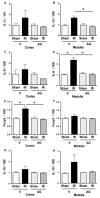
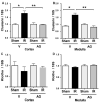
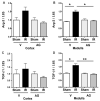

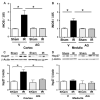
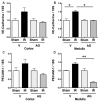
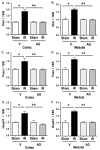
Similar articles
-
Glutathione S-Transferase and Clusterin, New Players in the Ischemic Preconditioning Renal Protection in a Murine Model of Ischemia and Reperfusion.Cell Physiol Biochem. 2021 Oct 27;55(5):635-650. doi: 10.33594/000000442. Cell Physiol Biochem. 2021. PMID: 34705356
-
The Ischemia and Reperfusion Injury Involves the Toll-Like Receptor-4 Participation Mainly in the Kidney Cortex.Cell Physiol Biochem. 2022 Nov 16;56(6):613-628. doi: 10.33594/000000586. Cell Physiol Biochem. 2022. PMID: 36378153
-
LPS ameliorates renal ischemia/reperfusion injury via Hsp27 up-regulation.Int Urol Nephrol. 2018 Mar;50(3):571-580. doi: 10.1007/s11255-017-1735-3. Epub 2017 Nov 9. Int Urol Nephrol. 2018. PMID: 29124510
-
Increased Renal 2-Arachidonoylglycerol Level Is Associated with Improved Renal Function in a Mouse Model of Acute Kidney Injury.Cannabis Cannabinoid Res. 2016 Sep 1;1(1):218-228. doi: 10.1089/can.2016.0013. eCollection 2016. Cannabis Cannabinoid Res. 2016. PMID: 28861493 Free PMC article.
-
Pioglitazone protects against renal ischemia-reperfusion injury by enhancing antioxidant capacity.J Surg Res. 2013 Oct;184(2):1092-5. doi: 10.1016/j.jss.2013.03.027. Epub 2013 Mar 25. J Surg Res. 2013. PMID: 23545406
Cited by
-
Elucidating the function of clusterin in the progression of diabetic kidney disease.Front Pharmacol. 2025 May 14;16:1573654. doi: 10.3389/fphar.2025.1573654. eCollection 2025. Front Pharmacol. 2025. PMID: 40438587 Free PMC article. Review.
-
Water-Soluble Products of Photooxidative Destruction of the Bisretinoid A2E Cause Proteins Modification in the Dark.Int J Mol Sci. 2022 Jan 28;23(3):1534. doi: 10.3390/ijms23031534. Int J Mol Sci. 2022. PMID: 35163454 Free PMC article.
-
Novel mechanism of the COVID-19 associated coagulopathy (CAC) and vascular thromboembolism.Npj Viruses. 2023;1:3. doi: 10.1038/s44298-023-00003-3. Epub 2023 Oct 18. Npj Viruses. 2023. PMID: 38077924 Free PMC article.
-
Antiglycation and Antioxidant Effect of Nitroxyl towards Hemoglobin.Antioxidants (Basel). 2022 Oct 11;11(10):2007. doi: 10.3390/antiox11102007. Antioxidants (Basel). 2022. PMID: 36290730 Free PMC article.
-
Advanced glycation end products mediate biomineralization disorder in diabetic bone disease.Cell Rep Med. 2024 Sep 17;5(9):101694. doi: 10.1016/j.xcrm.2024.101694. Epub 2024 Aug 21. Cell Rep Med. 2024. PMID: 39173634 Free PMC article.
References
Grants and funding
LinkOut - more resources
Full Text Sources
Research Materials
Miscellaneous

